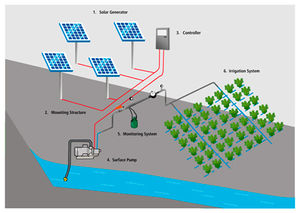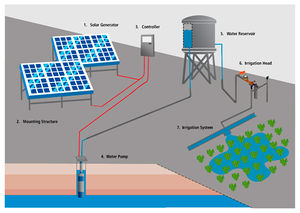Click here to register!
Difference between revisions of "SPIS Toolbox - Select SPIS Configuration"
***** (***** | *****) |
***** (***** | *****) m |
||
| Line 1: | Line 1: | ||
| − | |||
| + | {{SPIS Banner}} | ||
| + | === '''<span style="color:#879637;">Select SPIS Configuration</span>''' === | ||
| − | + | [[File:Configuration-solar.jpg|thumb|right|300px|Figure 1: SPIS configuration with a solar tracking system, surface pump and drip irrigation (Source GFA)]] [[File:Solar-panels-fixed.jpg|thumb|right|300pxpx|Figure 2: SPIS configuration with the solar panels fixed, submersible pump, a reservoir and surface irrigation (Source GFA)]] A SPIS can be designed in many ways; major variations will lie in the combination of key components: | |
| − | |||
| − | A SPIS can be designed in many ways; major variations will lie in the combination of key components: | ||
*solar mounting system (fixed or tracking); | *solar mounting system (fixed or tracking); | ||
| Line 12: | Line 11: | ||
*irrigation method – mainly drip or surface irrigation. | *irrigation method – mainly drip or surface irrigation. | ||
| − | An overview and description of different configurations of the individual components is provided in the '''GET INFORMED''' module. | + | An overview and description of different configurations of the individual components is provided in the '''[[SPIS - Get Informed|GET INFORMED]]''' module. |
Technically, any irrigation method can be combined with a solar water pump. However, it becomes a matter of cost. Pressure and high discharge require more energy and therefore higher costs. Drip irrigation, working at comparably low operating pressures and water efficient, suits solar pumping systems best. Yet, it requires that the producer learns new irrigation management skills. The suitability of a particular system configuration for a given farm depends on the water availability, the farm’s specific water requirements, its agricultural production and the producer’s skills and budget. | Technically, any irrigation method can be combined with a solar water pump. However, it becomes a matter of cost. Pressure and high discharge require more energy and therefore higher costs. Drip irrigation, working at comparably low operating pressures and water efficient, suits solar pumping systems best. Yet, it requires that the producer learns new irrigation management skills. The suitability of a particular system configuration for a given farm depends on the water availability, the farm’s specific water requirements, its agricultural production and the producer’s skills and budget. | ||
| Line 18: | Line 17: | ||
The human and financial resources required for maintenance should already be considered in the design of the system. As a rule, higher investments in good quality equipment outweigh the time and effort put into maintaining and repairing poor quality equipment. | The human and financial resources required for maintenance should already be considered in the design of the system. As a rule, higher investments in good quality equipment outweigh the time and effort put into maintaining and repairing poor quality equipment. | ||
| − | + | Figure 1 shows an SPIS configuration where one saves on the costs for the reservoir but spends on the tracking systems. The tracking system enables a relatively stable pump dis-charge which is important, because there is no reservoir to buffer the amount of water going to the field. The water can further be controlled by the valves and by splitting up of the drip irrigation system in sections. | |
| − | + | Figure 2 shows another, more common, configuration where water is pumped from the ground and stored in an elevated reservoir. The water goes through the irrigation head, which can be equipped with volumetric valves, and/or a fertigation system. Nevertheless the producer is forced to divide the field into small sections to allow a relatively controlled distribution of water across the field.This SPIS configuration requires relatively little maintenance as the panels and the pump are fixed. | |
| − | |||
| − | |||
| − | == Data Requirements | + | === '''<span style="color:#879637;">Data Requirements</span>''' === |
*Results of on-site data collection; | *Results of on-site data collection; | ||
*Results of comparative financial analysis. | *Results of comparative financial analysis. | ||
| − | == People / Stakeholders | + | === '''<span style="color:#879637;">People/Stakeholders</span>''' === |
*Producers; | *Producers; | ||
| − | *Agricultural | + | *Agricultural service providers; |
| − | *Technology providers/ | + | *Technology providers/system integrators. |
| − | == Important Issues == | + | === '''<span style="color:#879637;">Important Issues</span>''' === |
*PV water pumping works best with low pressure drip irrigation systems. | *PV water pumping works best with low pressure drip irrigation systems. | ||
| Line 41: | Line 38: | ||
*Varying hydraulic loads can be mitigated by are (a) using automatic valves, (b) adapting irrigation field size (c) and solar tracking. | *Varying hydraulic loads can be mitigated by are (a) using automatic valves, (b) adapting irrigation field size (c) and solar tracking. | ||
*Combining PV-based water pumping with traditional surface irrigation methods tends to be non-viable in financial terms. | *Combining PV-based water pumping with traditional surface irrigation methods tends to be non-viable in financial terms. | ||
| − | |||
| − | |||
| + | {{SPIS Reference}} | ||
| + | |||
| + | [[Category:Tools]] | ||
| + | [[Category:Powering_Agriculture]] | ||
[[Category:SPIS_Module]] | [[Category:SPIS_Module]] | ||
| − | |||
| − | |||
Revision as of 12:47, 7 June 2017

Introduction
The Toolbox on Solar Powered Irrigation Systems (SPIS) is designed to enable advisors, service providers and practitioners in the field of solar irrigation to provide broad hands-on guidance to end-users, policy-makers and financiers. Risks related to system efficiency, financial viability and the unsustainable use of water resources can thus be minimized. The Toolbox comprises informative modules supplemented with user-friendly software tools (calculations sheets, checklists, guidelines). read more
Modules and tools touch upon:
- assessing the water requirements,
- comparing the financial viability,
- determining farm profitability and payback of investment in SPIS,
- sustainably design and maintain a SPIS,
- highlight critical workmanship quality aspects,
- and many more.

Select SPIS Configuration
A SPIS can be designed in many ways; major variations will lie in the combination of key components:
- solar mounting system (fixed or tracking);
- motor pump installation (submersible or surface);
- integration of a reservoir or not;
- irrigation method – mainly drip or surface irrigation.
An overview and description of different configurations of the individual components is provided in the GET INFORMED module.
Technically, any irrigation method can be combined with a solar water pump. However, it becomes a matter of cost. Pressure and high discharge require more energy and therefore higher costs. Drip irrigation, working at comparably low operating pressures and water efficient, suits solar pumping systems best. Yet, it requires that the producer learns new irrigation management skills. The suitability of a particular system configuration for a given farm depends on the water availability, the farm’s specific water requirements, its agricultural production and the producer’s skills and budget.
The human and financial resources required for maintenance should already be considered in the design of the system. As a rule, higher investments in good quality equipment outweigh the time and effort put into maintaining and repairing poor quality equipment.
Figure 1 shows an SPIS configuration where one saves on the costs for the reservoir but spends on the tracking systems. The tracking system enables a relatively stable pump dis-charge which is important, because there is no reservoir to buffer the amount of water going to the field. The water can further be controlled by the valves and by splitting up of the drip irrigation system in sections.
Figure 2 shows another, more common, configuration where water is pumped from the ground and stored in an elevated reservoir. The water goes through the irrigation head, which can be equipped with volumetric valves, and/or a fertigation system. Nevertheless the producer is forced to divide the field into small sections to allow a relatively controlled distribution of water across the field.This SPIS configuration requires relatively little maintenance as the panels and the pump are fixed.
Data Requirements
- Results of on-site data collection;
- Results of comparative financial analysis.
People/Stakeholders
- Producers;
- Agricultural service providers;
- Technology providers/system integrators.
Important Issues
- PV water pumping works best with low pressure drip irrigation systems.
- The direct connection of the solar pump to the irrigation system leads to a dynamic and varying hydraulic load, which makes planning more complex.
- Varying hydraulic loads can be mitigated by are (a) using automatic valves, (b) adapting irrigation field size (c) and solar tracking.
- Combining PV-based water pumping with traditional surface irrigation methods tends to be non-viable in financial terms.





















